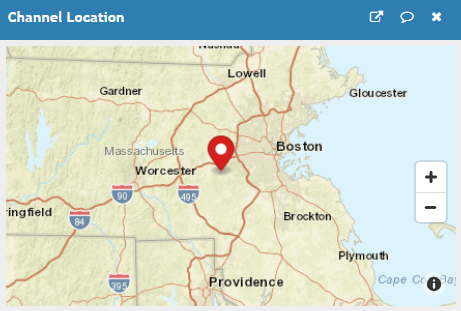通道属性
设置
在 My Channels 页面的 Channel Settings 选项卡中更改您的通道属性。您还可以使用 REST API 到 Write Settings。

Channel ID:自动生成的您唯一通道的 ID。您的应用程序使用此 ID 从通道读取数据。您无法改变其值。
Name:为 ThingSpeak™ 通道输入一个唯一的名称。
Description:输入 ThingSpeak 通道的描述。
Field#:选中该框以启用该字段,然后输入字段名称。每个 ThingSpeak 通道最多可以有 8 个字段。
Metadata:输入有关通道数据的信息,包括 JSON、XML 或 CSV 数据。
Tags:输入识别通道的关键字。用逗号分隔标签。
Link to External Site:如果您的网站包含有关您的 ThingSpeak 通道的信息,请指定 URL。这将成为您通道公共和私有视图上的 More Information 链接的目标。
Elevation:以米为单位指定传感器或收集数据的物体的位置。例如,伦敦市的海拔为 35.052。
Show Channel Location:选中此框可以在此页面输入通道位置数据。结果是在通道视图中显示带有位置精确点的地图。此位置为单一入口。通道源中的每个数据点还可以包含位置信息,这与此处显示的通道位置信息不同。即使清除此框,您仍然可以使用 API 读取和写入通道和源的纬度和经度信息。对于靠近极点的位置,看不到标记。

Latitude:以十进制度为单位指定纬度位置。例如,伦敦市的纬度是 51.5072。该值必须介于 -90 至 90 之间。
Longitude:以十进制度为单位指定经度位置。例如,伦敦市的经度为 -0.1275。该值必须介于 -90 至 90 之间。
Show Video:选中该框可在通道视图中包含视频显示,使用以下设置:
YouTube/Vimeo:选择您的视频服务。
Video URL:指定视频的完整 URL。
Link to GitHub:如果您将 ThingSpeak 代码存储在 GitHub® 上,请指定要在通道视图上显示的 GitHub 存储库 URL。
Show Status:选中此框可以向您的通道视图添加一个窗口来显示状态更新。该窗口可以显示从配置为将命令记录到此通道的TalkBack App执行的命令。状态还可以显示您使用状态参数通过 API 命令发送的信息,如 Write Data 中所述。

私人、共享和公共通道
您可以选择私有,公共或共享通道。在 My Channels 页面上,转至 Sharing 选项卡。

默认情况下,您的通道是私有的,需要读取 API 密钥才能访问其源。公共通道使其他用户无需读取 API 密钥即可使用您的源。您还可以创建一个与指定用户共享的通道。有权访问共享通道的用户只能看到通道的私有视图;他们无法添加通道、查看警报或查看许可证信息。
在私有和公共视图中,您都可以使用插件来实现可视化和分析。您还可以选择在每个视图中显示不同的插件。
注意
拥有免费许可证的用户只能与另外三名用户共享一个通道。
按标签搜索
您可以使用标签对您的公共和私有通道进行排序和过滤。通过添加用逗号分隔的单个单词或短语来在 Channel Settings 中设置标签。在 My Channels 中,您可以在搜索框中输入搜索标签,然后通道视图会进行过滤,仅显示带有该标签的通道。您还可以使用 Write Settings REST API Call 添加标签。

例如,考虑五种不同传感器类型的 10 个通道的集合。根据传感器类型为每个通道添加标签,您可以快速过滤以找到感兴趣的通道。
使用 REST API 控制通道设置
您可以使用 REST API 来创建、查看和修改通道。